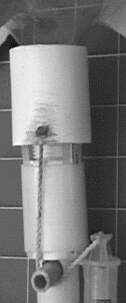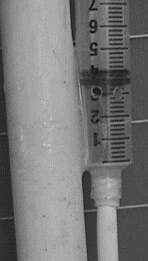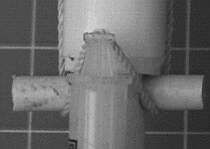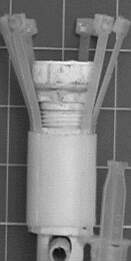The Clark cable-tie launcher
Building a launcher for water rockets can be daunting. Basically, you need to create a device that reliably grasps the rocket while you remotely pressurize it. The launcher must then release the rocket by a similar remote means. Ian Clark of Melbourne, Australia pioneered the use of “cable ties” as an elegant means to grasp and release the flange on soda bottles. The Clark design quickly became the de-facto standard in making water-rocket launchers because it works well and is easy to make. Bruce Berggren and Clifford Heath, two pioneers in water rocketry, provide pretty complete plans for launchers based on this concept.
Described here are my two innovations to the Clark launcher. I assume the reader’s familiarity with designs such as Bruce’s and Clifford’s, built principally of PVC plumbing parts obtained at the hardware store. My design employs a few elements in common with these designs: several cable ties are disposed around the circumference of the bottle neck, with a retaining or “trigger” ring that slides vertically around the outside of the ties to enable the cable-tie heads to grasp the bottle flange.
1. Air-actuated release
The rocket release is actuated by a 10cc syringe mounted to the side of the launcher. A bit of pressurized air in a secondary line leading to the syringe is all that is required to launch the rocket. I simply insert the remote end of the 1/4-inch vinyl secondary line directly into the Schraeder valve-head of a bicycle pump and one stroke is all it takes to launch a rocket.




As the syringe pressurizes, the plunger moves up, which then pulls the trigger ring down via a loop of string. This exposes the heads of the cable ties and releases the rocket. I drilled two holes in the side-wall of the syringe to release the pressure once the plunger has moved the minimum stroke length required to launch the rocket.
2. Launch tube is optional
In traditional Clark launcher designs, the launch tube is an integral part of the sealing mechanism and is not optional. For scientific reasons I want to be able to launch rockets with special nozzles and without a launch tube, so I made the launch tube optional. Here the rocket-bottle seals against an o-ring at the bottle's lower edge (rather than inside the throat). For this mechanism to work, there must be significant force pushing the bottle onto the platform containing the o-ring. The force between bottle and platform is communicated through the cable ties.
The rocket-bottle sits on a modified bottle cap that is glued to the top of a PVC pipe nipple. Inside the cap is the o-ring that seals against the bottle. The PVC nipple is threaded into the base of the launcher and contains an air conduit along its axis. By rotating the PVC nipple relative to the base, the platform moves up or down and changes the position of the bottle relative to the cable ties. This means you can adjust the tension force of the cable ties on the bottle. The air line leading from the pump to the movable platform is made of 1/4-inch vinyl irrigation tubing. Attached to the 25-cm-long removable launch tube is a nylon bolt with an air-hole drilled down the center. The launch tube is installed by threading the bolt into the platform.



In these pictures the trigger ring has been removed from the assembly to better show the platform, o-ring, and cable ties. The ends of the cable ties have been epoxied to the PVC base of the launcher, with a cut cylindrical section of 35mm film canister surrounding them and serving as reinforcement of the joints.
